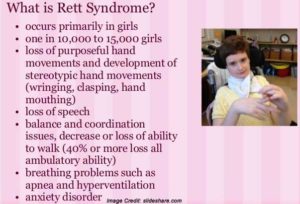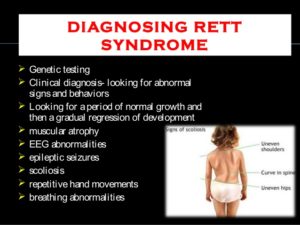The spectrum of phenotypes in MECP2-related disorders includes the following:
-
Classic Rett syndrome
-
Variant Rett syndrome
-
Mild learning disabilities (females) or neonatal encephalopathy and syndromic or nonsyndromic intellectual disability (males)
Classic Rett syndrome. In 1988, well before the discovery of the genetic basis of Rett syndrome, clinical diagnostic criteria were developed. The following are limitations to clinical diagnosis of Rett syndrome using these criteria:
-
Clinical diagnosis may be considered tentative until the affected individual reaches age two to five years, by which point she has likely gone through several stages of the disease.
-
Atypical forms may be either milder or more severe than classic Rett syndrome:
-
In the more severe variant, no period of grossly normal development occurs; and early manifestations include congenital hypotonia and infantile spasms.
-
In the milder variant, girls have less dramatic regression and milder intellectual disability.
-
Other children experience an even more gradual regression that begins after the third year, lose purposeful hand use, and develop seizures; however, they retain some speech and the ability to walk.
-
Revised Diagnostic Criteria for Rett Syndrome
The diagnosis should be considered when there is postnatal deceleration of head growth observed. However, this is not mandatory.
Required for typical or classic Rett syndrome
-
A period of regression followed by recovery or stabilization
-
All of the main criteria and all of the exclusion criteria
Supportive criteria are not required, although often present in typical Rett syndrome.
Required for atypical or variant Rett syndrome
-
A period of regression followed by recovery or stabilization
-
Two of the four main criteria
-
Five of the 11 supportive criteria
Main criteria
-
Partial or complete loss of acquired purposeful hand skills
-
Partial or complete loss of acquired spoken language or language skill (e.g. babble).
-
Gait abnormalities: impaired (dyspraxic) or absence of ability
-
Stereotypic hand movements including hand wringing/squeezing, clapping/tapping, mouthing, and washing/rubbing automatisms
Exclusion criteria for typical Rett syndrome
-
Brain injury secondary to peri- or postnatal trauma, neurometabolic disease, or severe infection that causes neurologic problems
-
Grossly abnormal psychomotor development in the first six months of life, with early milestones not being met
Supportive criteria for atypical Rett syndrome (currently or at any time)*
-
Breathing disturbances when awake
-
Bruxism when awake, is excessive teeth grinding or jaw clenching
-
Impaired sleep pattern
-
Abnormal muscle tone
-
Peripheral vasomotor disturbances
-
Scoliosis/kyphosis
-
Growth retardation
-
Small cold hands and feet
-
Inappropriate laughing/screaming spells
-
Diminished response to pain
-
Intense eye communication – “eye pointing”
*Younger individuals may need to be reevaluated, as the development of many of these features is age dependent.
Molecular Genetic Testing
Gene. MECP2 is the only gene in which mutation is known to cause MECP2-related disorders.

